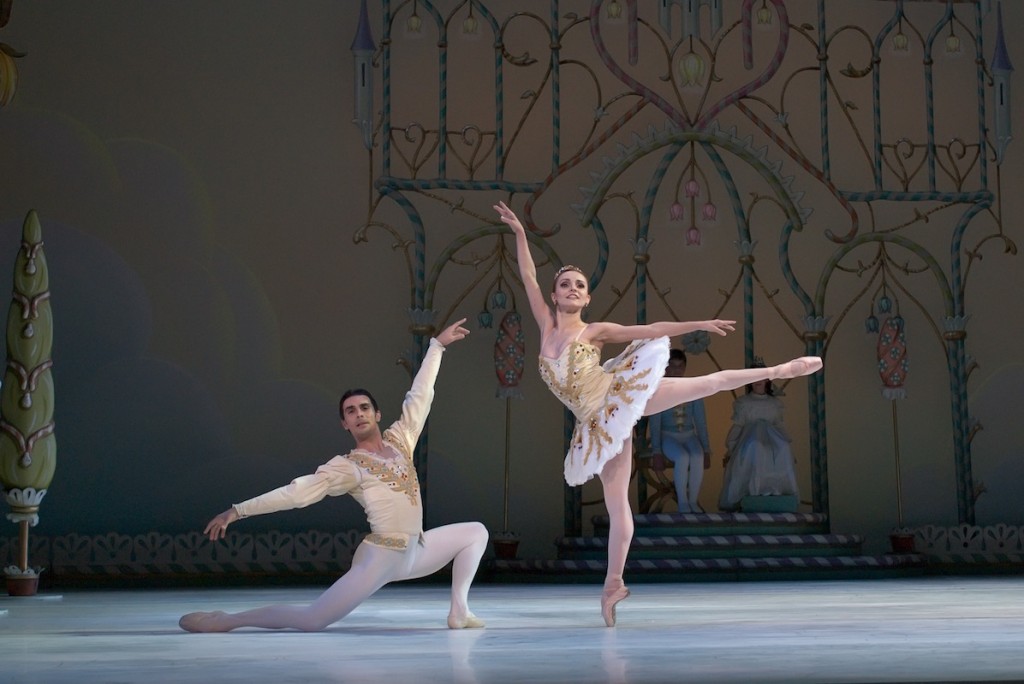Miami City Ballet’s “Nutcracker” opens with mixed performance at Kravis

Renato Penteado and Mary Carmen Catoya in Miami City Ballet's production of "The Nutcracker," which opened Friday night at the Kravis Center in West Palm Beach. Photo: Kyle Froman.
Miami City Ballet’s presentation of The Nutcracker began its annual run Friday night at the Kravis Center in West Palm Beach. Despite the immense popularity of this perennial holiday spectacle, there were a considerable number of empty seats in the theater.
First presented in 1954 by the New York City Ballet, George Balanchine’s choreographic realization of Tchaikovsky’s familiar score has attained such legendary status that it may seem heretical to suggest that this version does not represent Balanchine’s best work or the most vivid fusion of Tchaikovsky’s music and E.T.A. Hoffmann’s story The Nutcracker and The Mouse King.
Of course no work by this master choreographer can be totally dismissed. No one could devise dances for female corps like Balanchine. His sense of space, rhythm and symmetry found vivid expression in the ensemble sections of such masterpieces as Serenade, Theme and Variations and Mozartiana, all settings of Tchaikovsky orchestral scores. In The Nutcracker, the Dance of the Snowflakes and Waltz of the Flowers find the choreographer working at the height of his creative powers.
Elsewhere his choreographic inspiration is less consistent. Balanchine jettisons most of the macabre elements of Hoffmann’s story. In this version Herr Drosselmeier seems more like a lovable, eccentric uncle than the sinister character created by Hoffmann. The opening Christmas party scene is surprisingly mundane, overburdened with children’s dances. The second act divertissement is considerably more imaginative but Balanchine repositions the famous Dance of the Sugar Plum Fairy at the beginning of the act, thereby depriving the pas de deux of its female variation. (He also omits the male variation for the Sugar Plum’s cavalier, one of the score’s liveliest vignettes.) At the conclusion, there is no apotheosis of the heroine Marie awaking from her dream (despite the synopsis in the program book properly describing the scenario).
Still this streamlined Nutcracker can be great family entertainment when produced with flair and danced brilliantly, yet Miami City Ballet’s current production proved fitful in this respect.
Unlike the company’s repertoire programs, Nutcracker is danced to a recorded soundtrack rather than live orchestral performance. The taped version of the score was cleanly reproduced without distortion but inevitably hindered the dancers’ spontaneity. When Jose Varona’s sets were new in 1989, the production looked spectacular. Today the scenery seems worn and bereft of fantasy. Haydee Morales’ costumes are still lovely and enchanting but Alan Adelman’s lighting is drab in the Land of the Snowflakes scene, sometimes garish in the second act. This production has definitely not aged well.
The opening scene was danced somewhat listlessly, the children well drilled but cautious. Anna Gonzalez was a lovely Marie, capturing much of the wide eyed enchantment of the unsuspecting heroine. Yann Trividic did fine, larger-than-life, mime work as Balanchine’s sanitized Drosellmeier. Renan Cerdeiro’s athleticism in the toy soldier’s dance riveted attention. The light, airy duo of Michael Sean Breeden and Ashley Knox enchanted as Harlequin and Columbine. While the battle between the Nutcracker’s troops and the mice was staged with bravado, it emerged as more cartoon than nightmare.
The company’s superb female corps commanded center stage in the snowflakes scene, dancing with tight precision and energetic flair. As the Nutcracker Prince, Tommy Batchelor was properly hilarious and entertaining in his reenactment of the battle with the mice for the Sugar Plum Fairy. Jennifer Carlynn Kronenberg, a prima ballerina in the best sense of the term, was a world class Sugar Plum, imbuing her solo not only with fleet-footed spins but aristocratic phrasing and line. As Coffee, Callie Manning moved seductively in a surprising voluptuous and sultry solo turn.
One of Balanchine’s miscalculations was turning the Russian Dance into a piece for a group of candy canes dancing through hoops. Still Renato Penteado’s rapid dexterity excited the audience. Jennifer Lauren spun elegantly as a shepherdess. With Patricia Delgado absolutely beguiling and lithe as the Dew Drop, the Waltz of the Flowers exuded magic aplenty. Carlos Miguel Guerra joined Kronenberg for a memorable pas de deux, a miracle of rapid fire dynamism and musical grace in perfect proportion. Balanchine’s wonderful waltz finale brought back all the characters of the divertissement for a splashy Broadway conclusion, guaranteeing massive applause.
Despite this Nutcracker‘s shortcomings, it was wonderful to see so many young families genuinely entranced by the combination of great music and choreographic invention. Miami City Ballet needs a new production to display its often impressive dancers at their best. Perhaps it is time to give Nutcracker a rest and produce an inventive version of Cinderella to Prokofiev’s delightful but neglected score. That could be a holiday gift to delight children and balletomanes of all ages.
Miami City Ballet repeats The Nutcracker 2 p.m. and 7:30 p.m. Saturday and 2 p.m. Sunday at the Kravis Center in West Palm Beach.; 7:30 p.m. December 10, 2 p.m. and 7:30 p.m. December 11 and 2 p.m. December 12 at the Broward Center in Ft. Lauderdale; 7:30 p.m. Dec 17, 2 p.m. and 7:30 p.m. December 18 and 19, and 7:30 p.m. December 21, 22, and 23 at the Arsht Center in Miami. 877-929-7010, miamicityballet.org.
Posted in Performances
Leave a Comment
Sat Dec 4, 2010
at 11:04 am
No Comments






